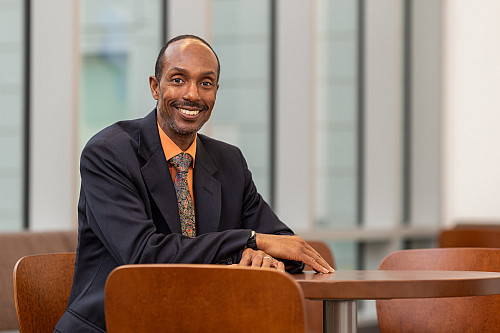Q&A with research subcommittee member
By IUPUI Today
January 24, 2023

IUPUI committees in each area of concentration have been working since October to develop measurable objectives, strategic actions and metrics appropriate to their area of focus.
The Transformative Research and Creativity group is made up of six subcommittees:
- Identifying High-Impact Transformational Research Areas of Focus.
- Supporting Translation of Research and Creative Activity to Encourage Innovation and Entrepreneurship.
- Strengthening Diversity, Equity and Inclusion Across the Research Enterprise.
- Enhancing Community-Engaged Research and Public Scholarship.
- Enhancing Support for Faculty Excellence in Research (including faculty retention).
- Improving Technological (IT) and Physical Infrastructure for Research.

Question: What are the main goals and ideas identified by your subcommittee?
Answer: I would break down our conversations into four areas. One would be well-being. In the context of research workload expectations and equitable support, well-being of students, staff, faculty and administrators was top of mind in our discussions. For instance, one of our recommendations targets more deliberate attention within units to recognize and honor the invisible labor, such as mentoring, often performed by faculty and staff of underrepresented populations, backgrounds and disciplines at a full-time equivalent higher than their non-underrepresented peers but disproportionately unrecognized and, therefore, not honored.
Impact was a second area. How should we as an institution and through our individual units be more intentional about how we’re defining research impact, allowing for diversification of impact, endorsing impact and awarding impact? One of our recommendations in this area focuses on deepening and expanding the institutional and unit-level culture such that more faculty are supported and successful in going up for promotion under an integrative case.
Retention was a third big piece, both in terms of tenure-track and non-tenure-track early career years and post-tenure/post full professorship years. We acknowledged that more support for research and scholarship is needed for our faculty across the spectrum of early career, mid-career and late career; however, currently there are more critical gaps and needs in the early-career and late-career phases that influence our retention rates. For example, as is found in some of our competing institutions, units should provide a sustainable structure for early-career faculty to take pre-tenure sabbaticals and late-career faculty to be awarded a second start-up package.
Providing pathways to success — providing the best possible support to help faculty progress through the promotion and tenure process — was the fourth major component of our discussions. Funding for those pathways was, of course, a lead concern. We have a recommendation there that looks at enhancing support for research staff and post-award operations.
Overall, we really focused on what I consider to be infrastructure to ensure that our foundation in these four areas is strong and equitable. By “infrastructure” I mean a framework of practices, operations and systems.
Q: What are some of your takeaways from the discussions?
A: These are my personal takeaways, not necessarily representative of the committee. The value of this kind of work is that it’s interdepartmental and interdisciplinary. For instance, I might typically reach out to a faculty member strictly for recruiting purposes. Opportunities such as serving on this research committee allow for engagement with colleagues outside of how we would normally interact. Approaches to problem-solving, decision-making and just life in general are enhanced by the nuances a different disciplinary lens brings.
The passion of the faculty on our committee was at the forefront of every meeting. They truly care about this institution. I felt that for each of them, the work they do is more than simply coming to work to do a job. We talked extensively about the invisible workload, particularly on those of nontraditional research pathways, and how to ease that burden. It was undeniable that they are committed to ensuring fairness and equity.
Bringing a staff person’s perspective to the committee was also tremendously important. We discussed how to better support individuals who, by the nature of their work, receive small(er) grants. These individuals make significant contributions to the research mission of schools and units. That includes post-docs, research techs and other individuals who serve in either lower profile academic roles or staff roles.
Their voices and needs too often are minimized, if acknowledged at all. I am always conscientious about marginalized or unheard voices, including people with a disability. My hope is that as our discussions and action steps progress, there is more institution-wide emphasis on how integral the talent, expertise, knowledge and perspective of this latter group are to our research missions.
Q: How is the subcommittee integrating Vision 2024, the realignment of IU and Purdue programs on the Indianapolis campus, in the planning process?
A: By thinking about how to best support our faculty, staff and students through the transition. That includes looking at funding mechanisms and how we can be more creative, interdepartmental and interdisciplinary in our approaches to research and research support.
Q: What would you like faculty, staff, students and the community to know about the IUPUI 2030 strategic planning process?
A: The administrators on my committee wore the hat of faculty. That spoke a lot to me. There was never a sense of, ‘I’m up here and you’re down there.’ It was always, ‘We’re in this together.’
The stakeholder engagement approach is effective. I was shocked to see my name surface to serve on the committee, and I know I’m not the only one who felt that way. That speaks to the reality that our administrators at the campus level, the school level and the department level are intentional about doing all they can do to ensure all voices will be heard.
It’s impossible for us to grow in the absence of research, learning and development. These pieces are absolutely fundamental to organizational growth. Whatever the cost, it’s always an investment, not an expense.